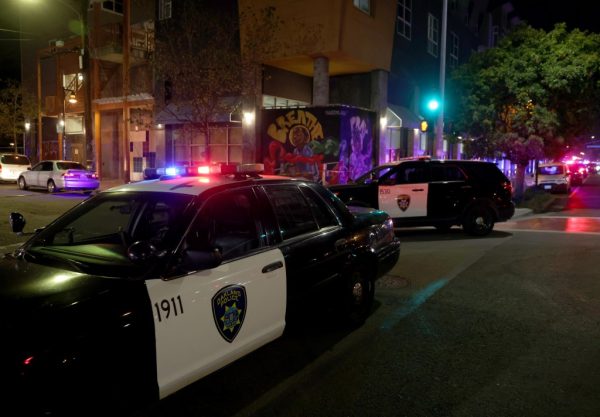Oakland’s homelessness continues
Pulling in from the freeway onto 17th Street in Oakland, two visibly homeless men stand on opposite sides of the street, beckoning the cars with their cardboard signs and empty paper cups. An “eyesore” for the city and its residents, little has been done to solve or at the very least alleviate homelessness with the immediacy it requires.
A topic which personally strikes a chord with us, it was jarring to try and talk to the people living in these makeshift encampments riddled throughout the city because it reminded us so much of our own past.
We scouted areas in downtown Oakland — bridges, under freeway overpasses and on the street. While the bolstering camp areas drowning in trash were set up, everyone was inside their tents, unwilling to talk. After no luck at an encampment on Sycamore and Northgate, we eventually ended up on San Pablo and Grand avenues, an area near the Oakland Greyhound station and homeless shelter St. Vincent DePaul. The few people who we were able to speak to there promptly steered us away as well.
In a report released in March for the 2015 year, the Alameda Countywide Homeless Count and Survey published that the point-in-time count “estimated number of sheltered and unsheltered people who were homeless in Alameda County on January 28, 2015 was 4,040.” However, this number could not possibly demonstrate the actual amount of homeless in the city of Oakland, putting into perspective their 406,253 population, according to the U.S. Census Bureau; much less the entirety of Alameda County.
While for some, homelessness may be a rock bottom period of their lives, others have had to adapt to this “lifestyle.” We finally met a young man named Dane, with his dog Pizza, who told us he’d just saved Pizza in Texas on his way to California on a freight train. He said he was kicked out of his mom’s house when he was 15 and now at 28, he’s been homeless for 13 years. When asked about any drug or alcohol use, he responded that he doesn’t touch anything and is simply looking for work.
Dane said being homeless has caused him stress, anger and depression. However, he shared some positivity as well, “All we got is time. We gotta use it to do the best we can,” and went on his way to panhandle for some dog food.
While we continued to “knock on the doors” of the tents by calling out and asking if anyone was home, we briefly interacted with a young lady named Mona. She was reluctant to speak and held her head down in shame while trying to talk to her. When asked how she ended up in the encampment, she simply replied, “I didn’t have anywhere to go.” Mona did not care to speak with us any further.
After seemingly no luck of trying to get answers from a first-person perspective about what the city has done to help, we took our questions to city hall. Assistant to the City Administrator, Joe DeVries, gave us a rundown of the efforts being done on the macro level — federal and state — to fund more housing in order to counterbalance the housing shortage.
“There’s a $2 billion affordable housing measure in the legislature right now and it will provide a lot of money for emergency shelters as well as temporary transitional housing, like single-room occupancy units, as well as permanent support housing for people who are truly disabled and not able to pay rent,” he explained. However, this is years along the line, it doesn’t provide immediate relief, which is what is truly needed.
DeVries explained that a large reason for the housing shortage is the tech boom in the Bay Area that is bringing more people in, while pushing others out. To solve the problem requires the building of more homes in an already concentrated area. To accommodate the influx of new residents, the homes cost much less to make than what they go for, which largely contributes to the affordable housing crisis.
According to DeVries, people that were squatting in what were once abandoned homes were kicked out and those homes were bought, fixed up, flipped and sold for $500,000 to $1,000,000 by developers. Those squatters ended up on the street, further increasing body count in the encampments.
On the local spectrum, DeVries mentioned that Mayor Libby Schaaf put together a housing cabinet with the objective of getting the homeless into permanent housing last winter, as the city has doubled spending for shelters since then. The main issue from the city’s perspective is the homeless people’s reluctance to stay at these shelters due to such strict guidelines, such as not being able to retain their belongings, no couples accommodations, no pets, chores and having to arrive and leave at set curfews.
Oakland’s model for transitional housing, or their service center for transition at many shelters, attempts to get homeless people on federal assistance, and has relocated some to other cities like Tracy and Modesto. DeVries said that they hope to triple housing funds within the upcoming months when the matter is brought to council.
Continuing our search for answers included a visit to Operation Dignity, a non-profit organization that assists the homeless in the city of Oakland, primarily assisting homeless veterans. Rachel Cole-Jansen, head of Mobile Outreach Services and program case manager, explained that they worked with the city’s Public Works Department in assisting the distribution of blankets, as they are involved in the city sweeps, or clearing an area of encampments.
She explained that there are Caltrans and Oakland city property boundaries that affects the people living in the encampments that may spill across either boundary when sweeps are scheduled because all of their belongings are dumped when Caltrans arrives. Residents also take advantage of the fact that the encampments are smothered in trash in order to do some dumping of their own.
Cole-Jansen said that Operation Dignity, along with Oakland’s Public Works Department have a system in place so that if for some reason the homeless cannot be there to move their things, for example being in the hospital, their things would be tagged and held for a period of 90 days. She said that on the other hand, “Caltrans doesn’t care.”
“They give [a 72 hour] notice and if the homeless’ belongings are not removed, Caltrans discards their belongings,” stated Cole-Jansen. An article in the East Bay Express investigating the same topic confirmed this, as it describes Caltrans workers who moved the homeless and their encampments in the pouring rain. One homeless woman named Kimmie commented in the comments section below the article and described Caltrans as “evil” for doing that to them.
Caltrans maintenance worker Mike Benca described the desensitization of the workers doing the sweeps and clean up. Benca got reassigned to the position of sweeps involving the homeless and his story lines up with Kimmie’s comments of how cruel some of the workers were, although some are hired through Adopt a Highway.
“Many of the homeless people are pushed from one side of the freeway to another. We are simply cleaning up their living area and then it’s on to the next site only to return within a month to clean up the same spot,” he said. “Every worker there knows that this is a perpetual chronic problem and that the state is not solving the crisis of homelessness and displaced people. Almost every time we remove a person and their encampment, they return within a few days. The process always repeats itself.”
Benca described some of the contract workers as short of being homeless themselves, yet they laugh at and ridicule the homeless when they throw their belongings away, taking what little dignity they have and stomping on it.
The descent to homelessness has numerous contributing factors. There isn’t one sole cause; however, lack of affordable housing is the big one. We hear so much from officials about ordinances or programs to alleviate this crisis, yet a mere drive around the city paints a much more crucial picture. Although Oakland hasn’t hit the immensity of the Los Angeles area homeless, it’s important to bear in mind that LA’s infamous Skid Row, the largest homeless concentration in the country, started off the same way.






